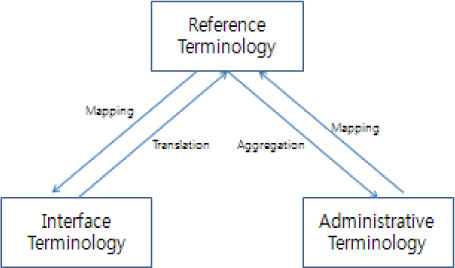J Korean Soc Med Inform.
2009 Mar;15(1):1-11.
Clinical Terminologies: A Solution for Semantic Interoperability
- Affiliations
-
- 1College of Nursing, Seoul National University, Korea. hapark@snu.ac.kr
- 2University of Salford, USA.
Abstract
- To realize the benefits of electronic health records, electronic health record information needs to be shared seamlessly and meaningfully. Clinical terminology systems, one of the current semantic interoperability solutions, were reviewed in this article. Definition, types, brief history, and examples of clinical terminologieswere introduced along with phases of clinical terminology use and issues on clinical terminology use in electronic health records. Other attempts to standardize the capture, representation and communication of clinical data were also discussed briefly with future needs.
Keyword
MeSH Terms
Figure
Reference
-
1. Kanter AS, Wang AY, Masarie FE, Naeymi-Rad F, Safran C. Interface Terminologies: Bridging the Gap between Theory and Reality for Africa, Proceedings of MIE. 2008. Goteburg, Sweden:2. Dolin R, et al. HL7 Clinical Document Architecture Release 2.0. Health Level 7. 2005. 05.3. Kalra D, Lloyd D. EN 13606 Health informatics - Electronic health record communication - Part 1: Referencemodel. Technical report. 2007. European Committee for Standardisation.4. Chen R, Beale T. Towards archetype-based semantic interoperability of the EHR, Proceedings of MIE. 2008. Goteburg, Sweden:5. Grieve G, Hamm R, Shafarman M, Mulrooney G. HL7 Template Specification. Health Level 7;2007.6. Logical Observation Identifiers Names and Codes (LOINC). Accessee March 20, 2009. Available at:http://loinc.org/.7. SNOEMD Clinical Terms. Accessed Mrch 20, 2009. Available at:http://www.ihtsdo.org/snomed-ct/.8. Chute CG. Clinical classification and terminology: Some history and current observations. J Am Med Inform Assoc. 2000. 7:298–303.
Article9. International Classification of Diseases. Accessed on March 20, 2009. Available at:http://www.who.int/classifications/icd/en/.10. Current Procedural Terminology. Accessed on March 20, 2009. Available at:http://www.ama-assn.org/ama/pub/physician-resources/solutions-managing-your-practice/coding-billing-insurance/cpt.shtml.11. Ingram D, Lloyd D, Baille O, Grubb P. The GEHR. Requirements for Communication Capacity. The Good European Health Record Project: Deliverable 9. 1992. Brussels: European Commission.12. Rosenbloom ST, Miller RA, Johnson KB, Elkin PL, Brown SH. Interface terminologies: facilitating direct entry of clinical data into electronic health record systems. J Am Med Inform Assoc. 2006. May-Jun. 13(3):277–288.
Article13. MeSH. Accessed March 20, 2009. Available at:http://www.ncbi.nlm.nih.gov/sites/entrez?db=mesh.14. Campbell KE, Oliver DE, Spackman KA, Shortliffe EH. Representing thoughts, words, and things in the UMLS. J Med Inform Assoc. 1988. 5:421–431.
Article15. International classification for nursing practice. Accessed March 20, 2009. Available at:http://www.icn.ch/icnp.htm.16. Production of ICD-11: The overall revision process (2007). Accessed March 20, 2009. Available at:http://www.who.int/classifications/icd/ICDRevision.pdf.17. ISO 18104: 2003 Health Informatics - Integration of a reference terminologymodel for nursing. 2003. Geneva: ISO.18. Guidelines for ICNP catalogue development (2008). Accessed March 20, 2009. Available at:http://www.icn.ch/icnp_Catalogue_Devlp.pdf.19. NANDA International. Nursing Diagnoses: Definitions and classification 2007-2008. 2007. Philadelphia: Author.20. Cote RA. Editorial: Ending the classification Versus Nomenclature Controversy. Informatics for Health and Social Care. 1983. 8(1):1–4.
Article21. Brouch K. AHIMA Project Offers Insights into SNOMED, ICD-9-CM Mapping Process. Journal of AHIMA. 2003. 74(7):52–55.
Article22. Bodenreider O. Issues in mapping LOINC laboratory tests to SNOMED CT. AMIA Annu Symp Proc. 2008. 51–55.23. Hyun S, Park HA. Cross-mapping the ICNP with NANDA, HHCC, Omaha System and NIC for unified nursing langue system development. Int Nurs Rev. 2002. 49(2):99–110.
Article24. Kalra D. Barriers, approaches and research priorities for semantic interoperability in support of clinical care delivery EHR, SemanticHEALTH. - D4.1, EC-supported FP6 SA. 2007. 12.25. EN 1828: 2002 Health Informatics Cetegorial Structure for Terminologies of Surgical Procedures. 2002. CEN.26. ISO/TC 215 WG 3 - Health informatics - Conceptual framework for patient findings and problems in terminologies. 2009. ISO.27. ISO 13606-2:2008. Health informatics - Electronic health record communication - Part 2: Archetype. 2008. Geneva: ISO.28. Center for Interoperable EHR. Accessed March 20, 2009. Available at:http://ehrkorea.org/eng/.
- Full Text Links
- Actions
-
Cited
- CITED
-
- Close
- Share
- Similar articles
-
- Use of clinical terminology for semantic interoperability of electronic health records
- Fully connecting the Observational Health Data Science and Informatics (OHDSI) initiative with the world of linked open data
- The Development of Clinical Document Standards for Semantic Interoperability in China
- Contribution of Clinical Archetypes, and the Challenges, towards Achieving Semantic Interoperability for EHRs
- Establishing semantic interoperability in the course of clinical document exchange using international standard for metadata registry


